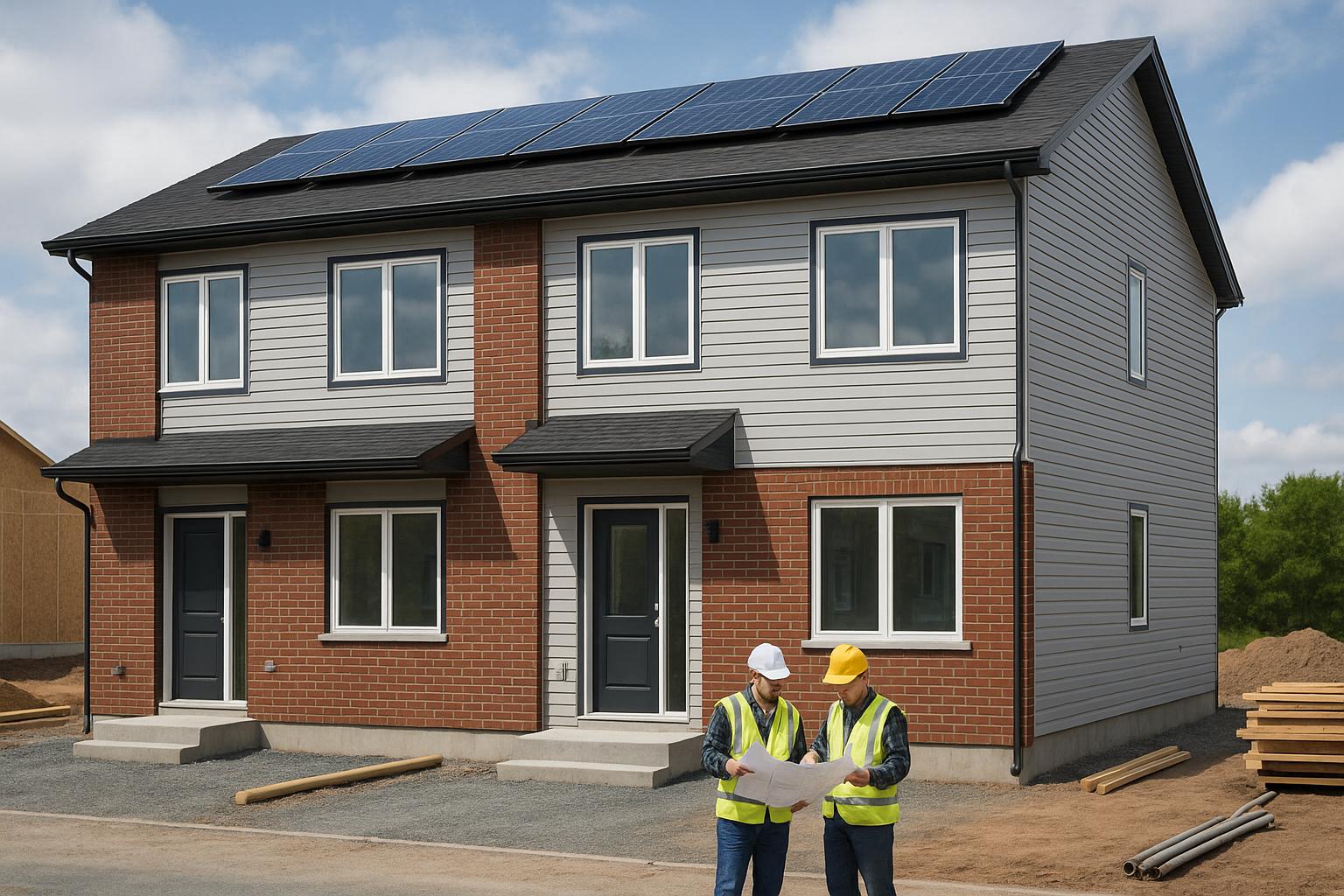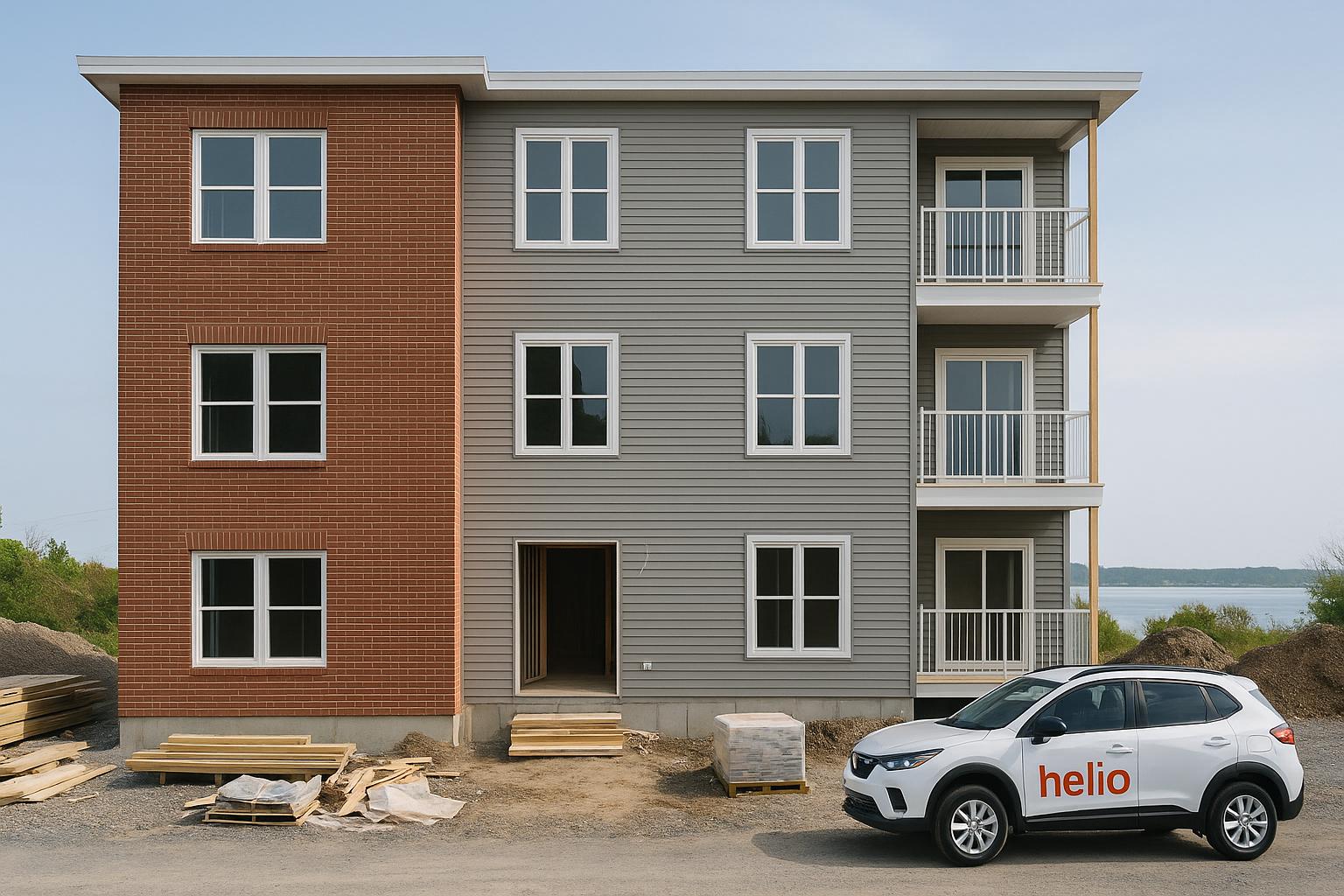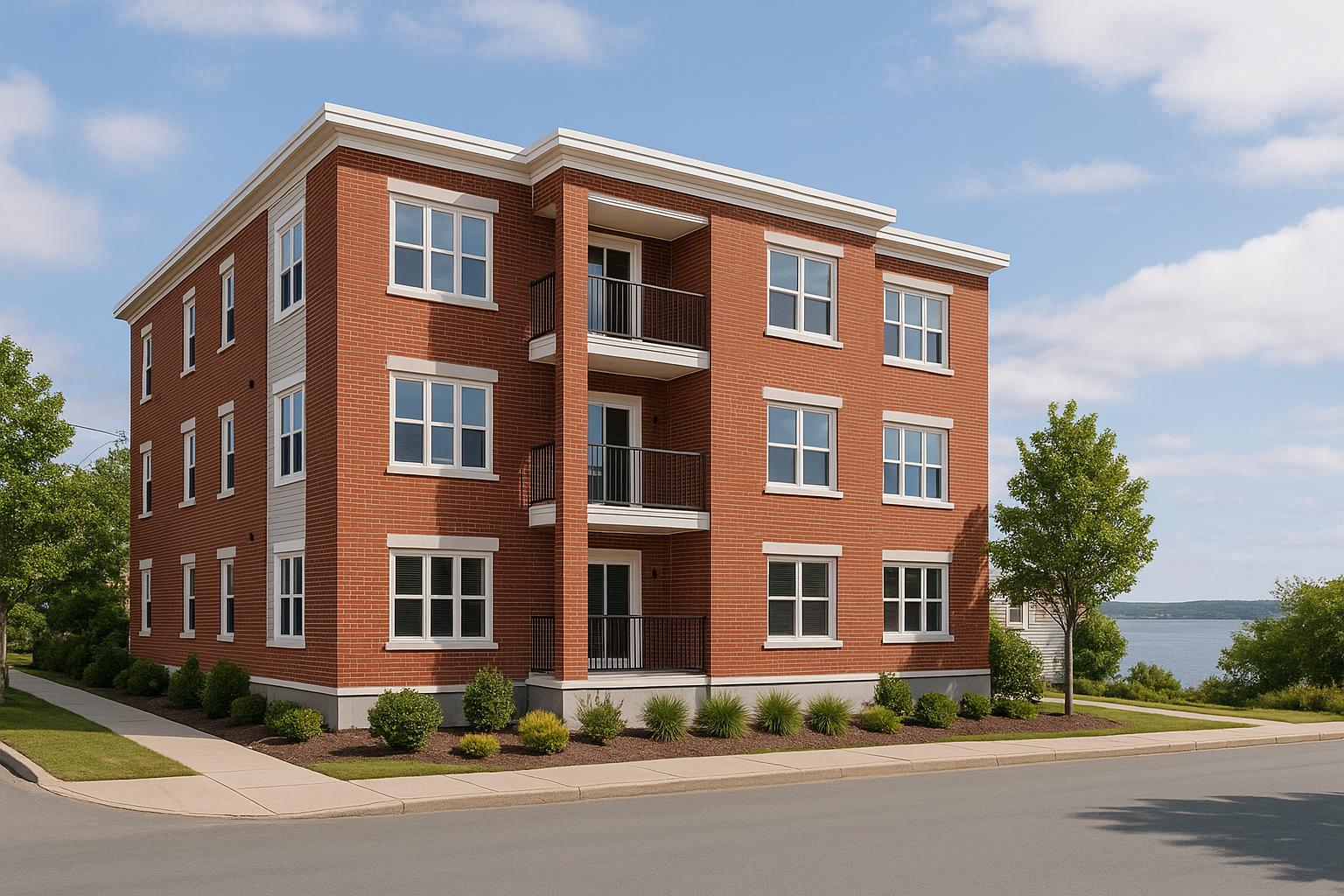Building multi-unit properties on sloped lots in Nova Scotia can be profitable but comes with challenges like water management, structural stability, and site preparation. Early planning, proper drainage, and choosing the right foundation are critical to long-term success. Integrated construction approaches - where one team handles everything - help avoid delays, cost overruns, and miscommunications.
Key Takeaways:
- Drainage is essential: Prevent water damage with proper grading, French drains, and retaining walls.
- Foundation matters: Stepped or pier foundations work best for steep slopes; walkout basements boost rental value.
- Plan early: Soil tests and geotechnical assessments reduce risks and ensure compliance with Nova Scotia's strict building codes.
- Integrated teams save time and money: Fixed-price contracts and single-team coordination streamline the process and improve accountability.
Done right, sloped lots can yield 12–20% annual ROI. Keep reading for detailed strategies on regulations, site prep, and design solutions.
How to fix house drainage problems around homes built on sloping land. #drainage #slopingland
Site Assessment and Regulatory Requirements
Before starting construction on a sloped lot in Nova Scotia, property owners face strict building standards and specific assessment requirements. These rules are detailed and can introduce unexpected challenges for developers who aren't fully prepared. These regulations play a key role in shaping site assessments and construction plans.
Municipal and Provincial Building Regulations
Nova Scotia adheres to the Nova Scotia Building Code Regulations (NSBCR), which incorporate the National Building Code of Canada 2020, the National Energy Code of Canada for Buildings 2020, and the National Plumbing Code of Canada 2020, including updates as of April 1, 2023 [3]. These codes govern the design, construction, and occupancy of both new buildings and renovations to existing ones [3].
For multi-unit buildings on sloped lots, professional design and oversight are required to address structural challenges and site complexities [3]. Additionally, municipal land use bylaws impose further rules, such as setback distances, density limits, and other local considerations. Municipal officials ensure all regulations are met and will not issue permits until compliance is demonstrated [3]. Submitting complete documentation upfront can save time and prevent delays. These regulatory steps naturally lead into the need for thorough site assessments.
Site Assessment Requirements
A professional site assessment is essential when dealing with sloped lots. Building officials may ask for a plan of survey or real property report prepared by a certified Nova Scotia land surveyor to confirm that the site and building locations meet regulatory standards [3].
Key aspects of site assessment include slope measurement, soil stability analysis, and grading in line with approved storm drainage plans. These steps are critical to ensuring a stable foundation and compatibility with municipal stormwater systems [3].
Nova Scotia's diverse soil conditions also make geotechnical assessments crucial. For example, clay soils can shift with changes in moisture, while rocky terrains might require specialized excavation methods. These factors directly influence foundation designs and broader construction strategies. Accurate assessments lay the groundwork for a smoother permitting process.
Permits and Documentation Checklist
To avoid delays, secure all necessary permits, such as those for on-site sewage systems, highway access, and engineered stormwater management [3].
Ensure all required documents - surveys, permits, and approvals - are complete and organized. This reduces the need for resubmissions and keeps the process on track. Proper documentation is key to meeting regulatory expectations without unnecessary complications.
Site Preparation and Earthworks
Preparing a sloped lot for construction comes with its own set of challenges. It requires specific techniques, tools, and strategies to ensure stable building platforms and efficient handling of materials, all while dealing with the difficulties of uneven terrain.
Excavation and Grading Methods
Levelling a sloped site often involves cut-and-fill operations, where soil is moved from higher areas to lower ones. This reduces the need to haul material off-site, saving time and costs. However, balancing the volumes of cut and fill can be tricky. To handle this effectively, track-mounted excavators are commonly used since they provide better traction on steep surfaces [4].
Equipment Access and Material Storage
Sloped sites often come with tight spaces and steep, potentially hazardous access routes [2]. Operating heavy machinery on uneven ground can lead to issues like reduced stability, equipment slippage, and faster wear and tear [5].
Transporting materials on slopes is another hurdle. Traditional methods can be less efficient, so alternatives like pumping concrete or using conveyor belts are often employed. While these solutions improve safety, they can also add to the overall costs [4].
Crane operations on sloped lots require extra attention. Level pads or specialized track-mounted cranes are essential for safe and effective use. Additionally, setting up secure, weatherproof staging areas early in the process helps avoid potential delays and safety risks [2].
Managing these complexities successfully often calls for a well-coordinated approach. When design, engineering, and construction teams collaborate from the start, they can streamline equipment access, material handling, and scheduling. This teamwork minimizes delays and unexpected costs, offering a more reliable alternative to disjointed, last-minute problem-solving.
Drainage Systems for Sloped Multi-Unit Properties
To protect foundations and avoid moisture seeping into basements or crawlspaces, it's crucial to grade the site so water flows away from the building's base [6]. On sloped properties, managing runoff is especially important to prevent water damage.
In Nova Scotia, municipalities have specific requirements to handle overland water flow effectively. For example, Annapolis County enforces rules to ensure runoff is redirected to safeguard neighbouring properties [6]. These regulations not only address immediate drainage concerns but also help maintain the property’s stability and structural health over time.
sbb-itb-16b8a48
Design Strategies for Stability and Rental Income
Transforming sloped land into a profitable rental property starts with smart design choices. By working with the natural contours of the land, you can create attractive, functional units that stand out in the rental market.
Building Orientation and Unit Layout
Split-level designs are a perfect fit for sloped sites, offering spacious and distinct living areas. For example, situating the main living spaces on the uphill side takes full advantage of natural light, while placing bedrooms on the lower level with walkout access seamlessly connects indoor and outdoor spaces. In Nova Scotia, walkout basements are a sought-after feature in the rental market.
Aligning the building's long axis parallel to the slope’s contour lines minimizes excavation and creates natural terracing opportunities. This design approach allows for separate entrances at different grade levels, making it easier to create unique layouts. Features like corner units with varying ceiling heights can help justify higher rental rates. These choices also influence the type of foundation required, ensuring both structural integrity and aesthetic appeal.
Foundation Types for Different Slopes
Choosing the right foundation is critical for both construction efficiency and rental potential. On moderate slopes, stepped footings work well, as they follow the natural grade while maintaining the necessary depth below the frost line. For steeper sites, pier foundations with grade beams are a practical option. This method reduces excavation and concrete use while creating space underneath for parking or storage. On the other hand, slab-on-grade foundations are better suited for gentle slopes but may limit the possibility of adding walkout basements, which are a valuable rental feature.
By tailoring the foundation to the slope, you can balance construction costs and rental income potential. Beyond the foundation itself, thoughtful exterior design plays a key role in ensuring long-term stability and tenant satisfaction.
Landscaping for Stability and Curb Appeal
Landscaping does more than enhance the visual appeal of a property - it also stabilizes slopes. Features like terraced gardens and retaining walls help prevent erosion while creating private outdoor areas that tenants will appreciate.
Choosing native plants like wild bergamot, Canada anemone, and red-osier dogwood can improve slope stability. These plants develop deep root systems that reduce soil erosion and require minimal upkeep. Additionally, integrating drainage swales into the landscaping can effectively manage stormwater runoff while adding attractive green spaces between buildings.
The secret to success lies in coordinating landscaping with other construction activities from the start. When earthworks, foundation installation, and final grading are planned as a cohesive process, the result is outdoor spaces that feel intentional and functional. This not only boosts tenant satisfaction but also increases the property’s appeal and rental income potential.
Integrated Construction: Avoiding Common Problems
Building multi-unit properties on sloped lots comes with unique challenges. From soil testing and drainage design to foundation engineering and final grading, each step requires precision. When these elements aren’t properly coordinated, property owners often face the dreaded trio: cost overruns, delays, and compromised quality - all of which can disrupt rental income plans.
The traditional approach to construction often fragments the process, leaving property owners juggling multiple contracts with planners, architects, engineers, and builders. On sloped terrain, where structural stability and effective water drainage demand meticulous planning and execution [1], this disjointed method can lead to costly mistakes. Integrated construction offers a solution by addressing these coordination challenges head-on.
Single-Team Coordination Benefits
Integrated construction teams streamline the process by turning disconnected tasks into a cohesive workflow. Instead of hoping that the drainage engineer’s plans align with the foundation contractor’s work, these teams collaborate from the start, ensuring everything works together seamlessly.
This approach is particularly crucial on sloped lots, where site preparation involves soil testing, proper grading to direct water away from the foundation, and installing effective drainage systems [1]. With a single team managing these elements, adjustments can be made in real-time - without triggering delays or costly change orders.
Another advantage is accountability. When issues arise, property owners don’t have to play detective to figure out whether poor grading, faulty waterproofing, or improper installation is to blame. The integrated team takes full responsibility for the system’s performance, saving both time and money.
Fixed Pricing and Timeline Guarantees
Cost overruns are a common problem in construction, especially with cost-plus contracts, where unexpected site conditions and coordination hiccups can inflate costs by 30–60%. Fixed-price construction offers a solution by locking in costs before the project begins. For example, property owners know upfront whether their four-unit building will cost $640,000 for standard construction or $800,000 for CMHC MLI Select qualifying units. This transparency allows for accurate financial planning and safeguards the project’s return on investment.
Timeline guarantees provide additional peace of mind. Some integrated builders even back their commitments with financial penalties, such as $1,000 per day for late completion. This ensures the construction team stays focused on delivering the project on time, rather than diverting resources to other jobs when challenges arise.
Quality Control Through Systematic Processes
Integrated construction also enables a level of quality control that fragmented methods can’t match. These teams implement systematic checks throughout the project, ensuring that critical elements like drainage and foundation stability are managed effectively.
For example, professional engineers can inspect key components - such as foundation waterproofing and drainage systems - multiple times during construction. This proactive approach catches potential issues early, preventing costly fixes down the line. Property owners can even bring in their own final inspector to ensure everything meets high standards.
Transparency is another hallmark of this approach. Daily photo updates let property owners monitor progress remotely, offering peace of mind as they see proper grading, drainage, and landscaping take shape according to plan.
Finally, integrated teams often back their work with two-year warranties on all construction, reflecting their confidence in the system they’ve built. By managing everything from earthworks to final finishes, they can guarantee the entire property’s performance, rather than shifting blame between contractors.
This coordinated, systematic approach becomes especially valuable on sloped lots, where the interplay between drainage, foundations, and landscaping directly impacts the property’s long-term stability and rental income potential.
Key Takeaways for Sloped Lot Development Success
When it comes to developing sloped lots in Nova Scotia, success hinges on careful planning and a unified construction approach. By following proven methods and collaborating with seasoned, integrated teams, property owners can maximize rental income while avoiding costly mistakes that often lead to structural issues.
Best Practices Summary
Start with a thorough site evaluation.
Conducting soil and ground testing early on is crucial. This step helps identify necessary foundation adjustments and minimizes the risk of expensive repairs down the line.
Plan drainage systems from the outset.
Proper grading and drainage solutions - like French drains and retaining walls - are essential to protect the foundation and prevent water damage.
Prepare for Nova Scotia's unique climate.
The Atlantic region’s weather demands special attention during construction. Reinforced framing can handle strong winds, while roofs should be designed for heavy snowfall. Effective moisture barriers, high-quality windows, and proper insulation are also key to creating durable and energy-efficient buildings.
Match the foundation to the slope.
The type of slope determines the best foundation solution. Steep grades may require stepped foundations or retaining walls, while gentler slopes might support walkout basements, which can boost rental value. Choosing the right foundation ensures the property aligns with both the terrain and your income goals.
These strategies form the backbone of an integrated construction approach, which simplifies coordination and improves accountability throughout the project.
Why Integrated Construction Works
An integrated construction strategy builds on these best practices by addressing common challenges head-on. Traditional construction often involves multiple contractors working independently, which can lead to miscommunication and delays - especially on complex sloped terrains.
With an integrated approach, all specialists collaborate under one team. This ensures seamless planning and execution, with real-time adjustments that reduce delays and unexpected costs.
Fixed pricing ensures financial clarity.
Fixed-price contracts provide transparency, locking in costs and timelines. For example, a standard four-unit building might cost CA$640,000, while a CMHC MLI Select qualifying project could run around CA$800,000. This clarity helps property owners plan their budgets and protect their expected rental returns.
Guaranteed timelines keep projects moving.
Rental properties only generate income once they’re completed and occupied. To ensure timely delivery, some builders offer penalties - like CA$1,000 per day for delays - so your project stays on track, even when challenges arise.
Proactive quality control prevents issues.
Integrated teams include professional engineers who inspect critical elements, such as foundation waterproofing and drainage, multiple times during construction. This systematic approach catches potential problems early, while strong warranties provide added peace of mind.
"Our team understands the engineering, reinforcements, and design strategies needed to make sloped-lot sunrooms both safe and stunning."
– Sunspace Nubuild
FAQs
What challenges come with building on sloped lots in Nova Scotia, and how can they be addressed?
Building on sloped lots in Nova Scotia comes with its own set of challenges, thanks to the region's varied terrain and weather. Uneven ground demands thorough planning to create a solid foundation and ensure proper drainage. Without these precautions, water pooling and structural damage can become serious issues. To manage runoff, solutions like grading, French drains, or retaining walls are often necessary.
The type of soil on the lot is another critical factor. Both the slope and soil composition directly affect how the foundation is designed and can significantly influence construction costs. Conducting a soil test is a must to confirm the land can safely support the structure. Sloped lots often call for creative design approaches, such as multi-level layouts or retaining walls, to make the most of the space while keeping safety in mind. Nova Scotia’s harsh climate, with its freeze-thaw cycles and heavy rainfall, adds another layer of complexity, making it important to use durable materials and reinforced construction techniques.
Although building on a slope can lead to higher costs due to the extra work needed for site preparation and machinery access, careful planning can help navigate these obstacles. With the right approach, you can achieve a stable, long-lasting property that holds its value over time.
What are the advantages of using an integrated construction approach for building rental properties on sloped lots in Nova Scotia?
An integrated construction approach offers plenty of benefits for property owners tackling projects on sloped lots. By bringing everything under one roof - design, earthworks, drainage, and construction - this method ensures smoother coordination and minimizes the chances of delays or miscommunication. Instead of juggling multiple contracts and teams, property owners deal with a single point of accountability, making the entire process far more manageable.
This method also helps keep costs in check by reducing unexpected expenses and keeping the project on budget. With all teams working together, the unique challenges of sloped lots - like managing drainage and ensuring stability - are addressed efficiently. At the same time, the property's long-term durability and profitability are prioritized. For property owners, this means fewer headaches, a more seamless process, and the confidence of knowing their rental property will be built to a high standard.
What should I consider for proper drainage and stable foundations when building multi-unit properties on sloped land in Nova Scotia?
When constructing on sloped land in Nova Scotia, managing drainage and ensuring a stable foundation are key to protecting your property over the long term. Start by grading the land so that water naturally flows away from the foundation. Direct this runoff into approved drainage solutions, such as swales or rain gardens, to prevent pooling and erosion. For handling heavy rainfall, overland flow systems are a good choice, while piped systems work well for managing regular runoff.
To keep the foundation stable and dry, apply a waterproof membrane, install weeping tiles surrounded by clean gravel, and ensure downspouts channel water well away from the building. Regular upkeep of drainage features like ditches and storm drains is also important to comply with local standards and avoid future problems. These measures will help protect your property from water damage while maintaining its structural strength.
Related Blog Posts
- Building on the Nova Scotia Coast: How to Design and Construct Durable Seaside Home
- Designing Your Nova Scotia Coastal Dream Home: Embrace the Ocean, Resist the Elements
- Designing to 11 m (+3 m Pitched-Roof) in ER-3 (ER3): Squeezing Volume on Small Lots
- Basement vs Slab in Nova Scotia: Cost, Risk, and Site Conditions



